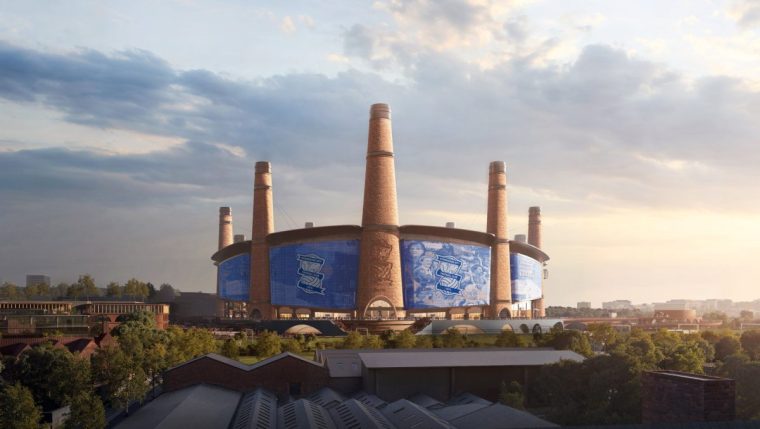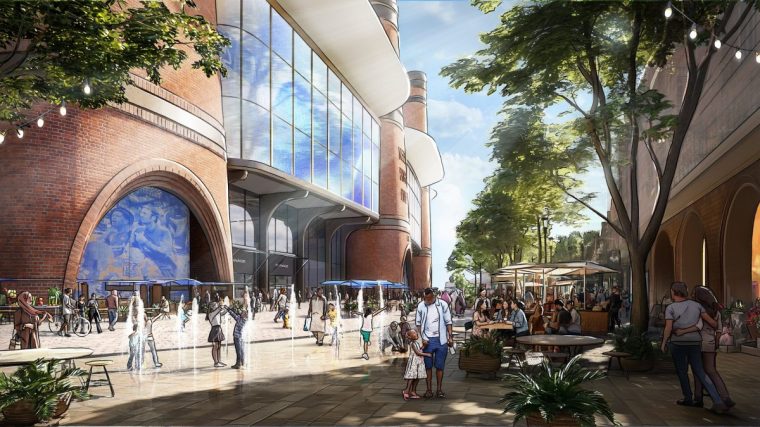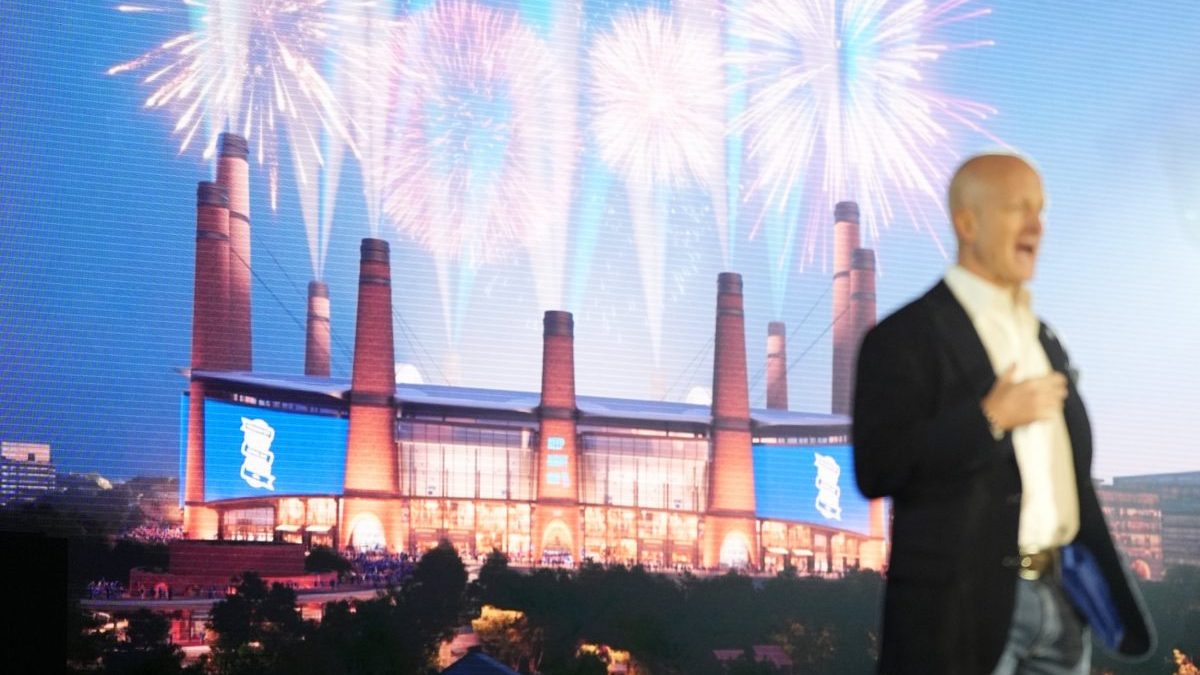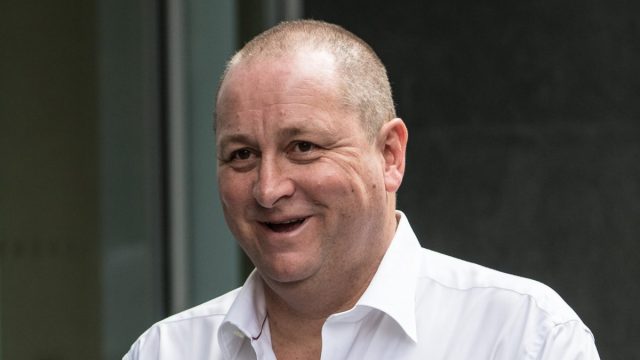Twelve chimneys, one ambitious plan to make a stadium the heartbeat of a year-round complex that relies on HS2 – can it work?
DIGBETH – By order of the Peaky Blinders, Birmingham City’s new “Powerhouse” stadium will feature a grand total of 12 chimneys, and with Santa spoiled for choice one will even house the city’s highest bar. Chim chim… sherry?
This was the day a vision finally supplemented the dream for curious Bluenoses and the club’s ambitious owners Knighthead. Now for the hard part, making them concrete (with a whole load of brick) and ensuring this £1.2bn, 62,000-seater stadium is billowing smoke by the 2030-31 season.
“This was not the time for a shiny new structure,” Birmingham co-owner Tom Wagner said on Thursday. “It was time for a rebirth. To celebrate the old and make it relevant and inspiring for this and future generations.”
The Peaky Blinders effect is plain to see. The TV show’s creator, Steven Knight, was the local voice during the design process, and it was at his Digbeth Loc Studios – a mile away from the site Birmingham plan to transform into the Sports Quarter complex – where the plans were unveiled in front of fans.
 Birmingham City’s new stadium will feature 12 chimney towers (Photo: Heatherwick Studio)
Birmingham City’s new stadium will feature 12 chimney towers (Photo: Heatherwick Studio)
 Inside the stadium Blues hope to be ready by 2030 (Photo: Heatherwick Studio)
Inside the stadium Blues hope to be ready by 2030 (Photo: Heatherwick Studio)
No expense was spared, and with Jude Bellingham featuring prominently in the promo video, Wagner’s response was swift when asked if he hopes the new stadium could one-day entice the England midfielder back.
“Duh,” he said, before being asked to expand. “I think Jude is the greatest player on the planet today. I don’t think we’ve seen his potential yet. It would be a great story.”
Though a hark back to the city’s industrial past, the focus was on the future. There are hopes to host NFL games and global competitions, while a retractable roof and moveable pitch enables a flexibility to stage concerts as well.
“Too often stadiums feel like spaceships that could have landed anywhere, sterilising the surrounding area,” Thomas Heatherwick, founder and design director of Heatherwick Studio, said.
“This stadium grows from Birmingham itself – from its brickworks, its thousand trades, and the craft at its core.”
My one nagging stadium doubt: answered
The stadium promises to be the heartbeat of a year-round destination that also plans to feature markets, cafes and restaurants.
The Sports Quarter proposals therefore exceed those typical for a new stadium. Undoubtedly Tottenham Hotspur elevated the matchday experience in this country, encouraging supporters to gather for hours before and after games, but Spurs’ stadium is not a 365-day-a-year destination.
So what makes Blues so confident they can be different?
It is my nagging doubt. As a Brummie who grew up when Star City – a vast entertainment complex just off the Spaghetti Junction – was unveiled, the initial excitement was quickly tempered by the reality of its location. It was a mission to get to, and after a couple of visits, I plus many friends and family have never been back.
The city does not need another white elephant, therefore, but naturally Wagner came prepared and believes people will want to go back, particularly thanks to the £400m tram extension which was given the green light earlier this year, and the eventual completion of HS2.
 Blues want the stadium to be the hub of a Sports Quarter (Photo: Heatherwick Studio)
Blues want the stadium to be the hub of a Sports Quarter (Photo: Heatherwick Studio)
“I would have been a lot more sceptical about the ability to use this every single day if it were not for national government coming through with the transport funding. It becomes incredibly accessible,” Wagner said.
“Ultimately what will drive the interest is the quality of entertainment. I can promise you the people we’re working with know exactly what those acts want because they’re the ones who decide where they go. We know who to go to to make sure we have a place that is full the whole time.”
Eliot Postma, Heatherwick Studio partner and group leader, then weighed in. “Right now the site is an ‘island’ but it has so much potential to become a desire line for the communities surrounding it.
“You’ve got Digbeth next door which I’ve read is the coolest place in the UK right now. There’s so much opportunity for this to be a stepping stone.
“So many stadiums when they touch the ground on a non-matchday, they give nothing back. For it to become the heart of that community, is a big part of the thinking.”
Knight then completed the hat-trick in the post-reveal press conference, the lifelong Bluenose referencing the change in how we shop as a reason why this place can still thrive.
“We’re seeing city centres suffering,” Knight said. “I think now people will go to a location for experiences. Not to come away with shopping, but to have an experience.
“If we have that hub, then that’s the future. Whether the chimneys reflect something from 150 years ago or not, that is the future.”
Your next read
To which, Wagner noted: “People are looking for more analogue experiences, to interact. This can be where analogue meets digital.”
For now, that’s me told, and convinced, and while there will be many Blues fans who will not care a jot about anything beyond watching their team play football, the wider elements promised are vital to this project becoming a success.
Come for the chimneys, come back for the entertainment? As 2030 approaches, it will become clearer just what that entails.

